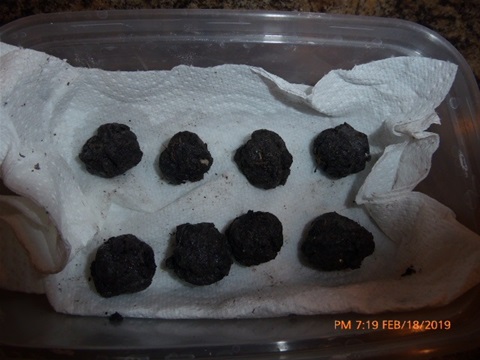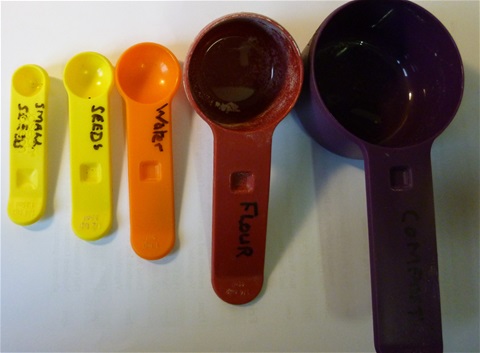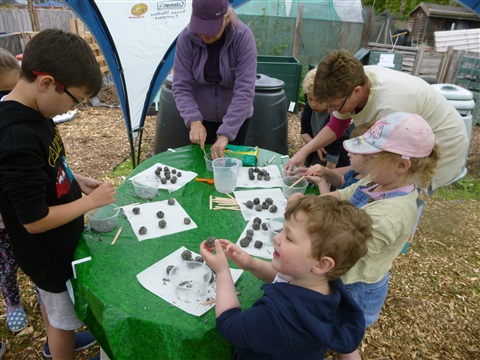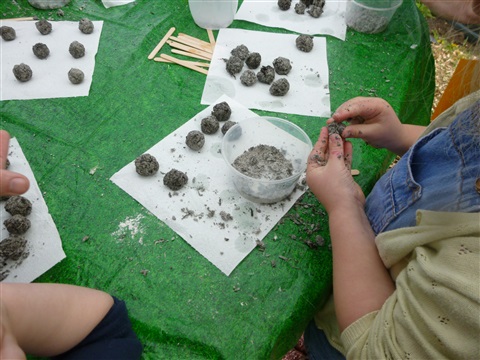Seedballs or Seedbombs
Seedballs, Seedbombs or earth balls are used for “seed bombing” where the balls are thrown or dropped by hand or from the air into the area where they are to germinate .
Sowing Seedballs directly in the field was a technique used in ancient Egypt and by North American First Nations’ tribes and is now being used for the large-scale regeneration of land.
Seedballs dropped from the air usually contain the seeds of trees to create forests while those thrown by hand are often used for planting wildflowers in abandoned vacant and neglected areas of towns and cities. They also provide a means of sowing wild flowers in school grounds and allotment sites.
Clay based Seedballs
The conventional Seedball is made by rolling the seeds in a ball of compost which is coated with a layer of wet clay or, in a variation of the method, the seeds, compost and clay are all mixed together when making the ball. The compost and clay act as a carrier for the seeds so they can be thrown into inaccessible areas. Each seed ball provides the seed(s) with a mini ecosystem. Where the balls are made commercially, they are normally about a 1cm in diameter a size which makes scattering, but home-made versions tend to vary and are often larger. The clay provides a shell protecting the seed and nutrients in the compost from predators e.g. as birds, ants and rodents. However, as this technique will normally require the purchase of clay there is an alternative suitable for allotment sites and schools using flour instead of clay.
The completed balls are then placed, or more often thrown, into the garden or ground where it is hoped the plants will grow. There are techniques where the seeds are spread form aircraft, but my view is that this is unlikely to be used on allotments or school grounds and domestic gardens, so no further details are given here. Seedballs can also be used for planting in pots and raised beds. The seeds will remain dormant until their environmental needs are met. When enough rain has permeated the clay, the seeds germinate with the initial growth of the plant being helped by the nutrients and minerals in the compost. After about three weeks the first seedlings work their way through the seed bomb and root into the ground below. As they grow the seed bomb begins to dissolve.
There are variations to the basic recipe one used by Seedballs (https://www.seedball.co.uk/ ) are made with the addition of chilli to help protect the seed from predators.
Choosing Seed Mixes:
If planning to create a wild seed meadow it
is important to choose the right seed mix and to prepare the land first. (Most specialist wild seed suppliers offer advice e.g. https://www.wildflowershop.co.uk/Info%20&%20Advice/meadow%20creation.htm
https://hub.suttons.co.uk/childrens-corner/how-to-make-seed-bombs
Seed Balls Recipe
This activity is suitable for use at those parts of the year when seeds will germinate outdoors usually April – June in the UK but do check the labels of the seed to be used. Two recipes are given. The traditional clay ball and a flour and compost ball which avoids the need to order clay.
At schools I normally make seedballs in groups of three with each child making three balls to take away at the end of the session. However, if the plan is to seed bomb a school garden each student may only make one bomb and the bombing will take place in small teams with each team bombing a marked off section of the garden. When the seeds have germinated the students can see how effective they have been in covering the whole of the target area.
Costs of 100g of wild flower seed will cost about £20 -£26. The number of seeds per gram will vary considerably depending the plants in the mix e.g. a gram of Yellow 20 1 g of Flag iris will contain approximately 20 seeds while 1-gram Common centaury (Centaurium erythraea) will contain approx. 80,000 seeds. Seeds of common garden flowers can be colected for free and used immediately or be saved to be sown next year.One of my favourate plants for this activity is the Poppy as seeds can be easily collected and saved.
The compost used in this activity can be purchased from the local garden centre, but it is better if homemade seed compost is used as this will demonstrated a use for the compost produced from the kitchen ,fruit and garden waste. Follow the link to find a recipe to make seed and potting compost Seed & Potting Mixes
It saves time and wastage if the teacher/trainer has weighed the seed in advance and dispensed them into containers or has provided pre-marked plastic measures. I have modified the quantites used in the activity below for use with common kitchen measuring spoons. The use of measures speed the activity enabling one composter to dispense compost , flour and seeds into the pots for mixing.
Flour Seedballs
1/2 cup compost,
1/4 cup of flour,
1/2 tsp seeds (or 1/4 tsp if the seeds are very small)
Equipment
Plastic measuring scoops/measures 1/2 cup, 1/4 cup, 1 tsp ), 1/2 tsp or 1/4tsp for very small seeds
A mixing bowl or plastic "take away" container for each person
Lolly sticks for mixing the compost, flour and seeds
Water
Plastic trays to contain spillage
Grease proof/wax paper or kitchen towel for drying the seed balls
Cardboard egg boxes if seedball are being taken from the site
Disposable vinyl gloves and plastic apron (optional)
Method
Measure out 1/2 cup of compost and mix in 1/4 cup of flour. Stir in 1/2 or 1/4 tsp of seeds and mix well.
Stir in 1tsp of water and mix first with the lolly stick and then by hand. Continue mixing until the mixture can be formed into a ball. It may be necessary to add up to three teaspoons of water if the compodst is dry. The mixture should change colour from grey to brown when squeezed
Divide and roll into 8-12 seedballs. The 1tps measure can be used to measure the size
Put the balls in the egg tray or take-away container and leave to air dry for at least a day
The seedballs can be put dropped or thrown onto the area being seeded. If thrown these flour seedballs are more likely to break up on impact with the soil than those coated in clay. They are best thrown immediately after a shower or when rain is expected.
Making the clay seedballs
- Wearing the gloves weigh or measure the 25g seeds and the 200g compost into a bowl or plastic container
- Gently mix the seeds and compost with a spoon or by hand.
- Add the dry red clay and mix again.
- Slowly add water while continuing to stir and mix the seeds, compost, and water to form an evenly mixed paste.
- Line the plastic tray with wax paper
- Hand roll the material containing the seeds, compost and clay into a ball of about 25mm in diameter
- Put the seed balls on the tray and allow to airdry for at least a day. If the seed balls are to be taken away from the session before they are dry gently wrap them in the wax paper to air dry at later.
Once the balls are dry throw




Latest comments
Do you have any data on ' application ' of Aerated Vermi Compost Tea to Mangoes and benneficial outcomes .
Very informative site. Having been away for 5 weeks and returning to evidence of rats under and around the compost bin, I can testify to lack of human activity allowing the rats to get comfortable.
can i use dog manure in compost and mulching leaves?
What is the C and N ratio for coffee chaff?